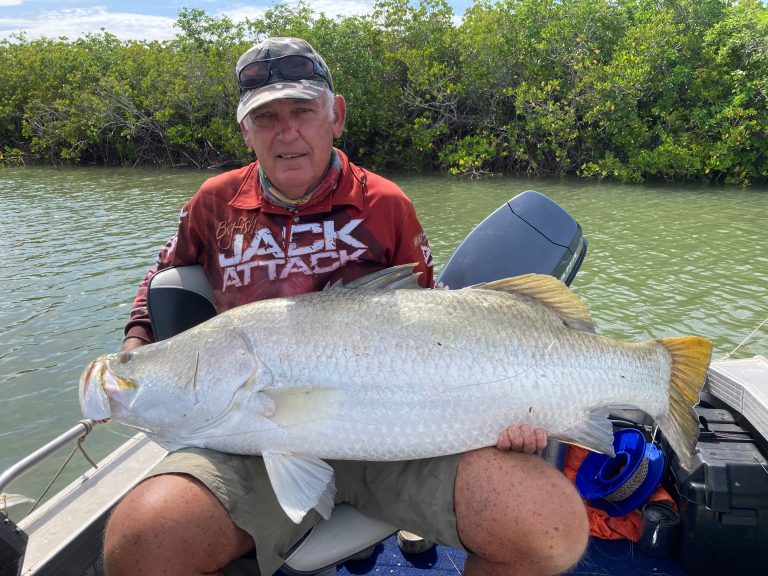A Metre Barramundi and Others – Full Moon Potpourri – By Bill Bowtell
The phone rang. It was Adrian Frick. In his cheery way, he described that he was now officially retired, having just sold his dental business, and that he wanted to go fishing! This was something that we had discussed a couple of times since first meeting a few years back.
Adrian’s fishing background centered around several years in the remote communities of Bamaga and Cape York, where he was operating as the local dental practician. This gave him access to some great fishing locations, and the options that each spot had to offer. His stories of fishing trips, and of the fish, in these remote areas, were infectious. And having spent more than five years in the Gulf country, as well as working in the remote communities on the western side of Cape York myself; we had a lot in common. A point that was not lost on Adrian, or his wife Michelle, who shared every adventure with him.
It was obvious from the outset of the phone call that he was ready there, and then, to start the trip north up to Yeppoon from his home town of Bundaberg. But! There was only one snag: I was in Tasmania visiting my daughter Sally, and trying to catch that illusive fly-caught trout. The trout was never going to happen – wind, rain, hail, snow and electrical storms, causing flooding, put paid to that little quest. I told him that I would be back in Yeppoon on the 20th October and to head on up later that week. He and wife, Michelle, arrived on the 21st; right on the Full Moon.
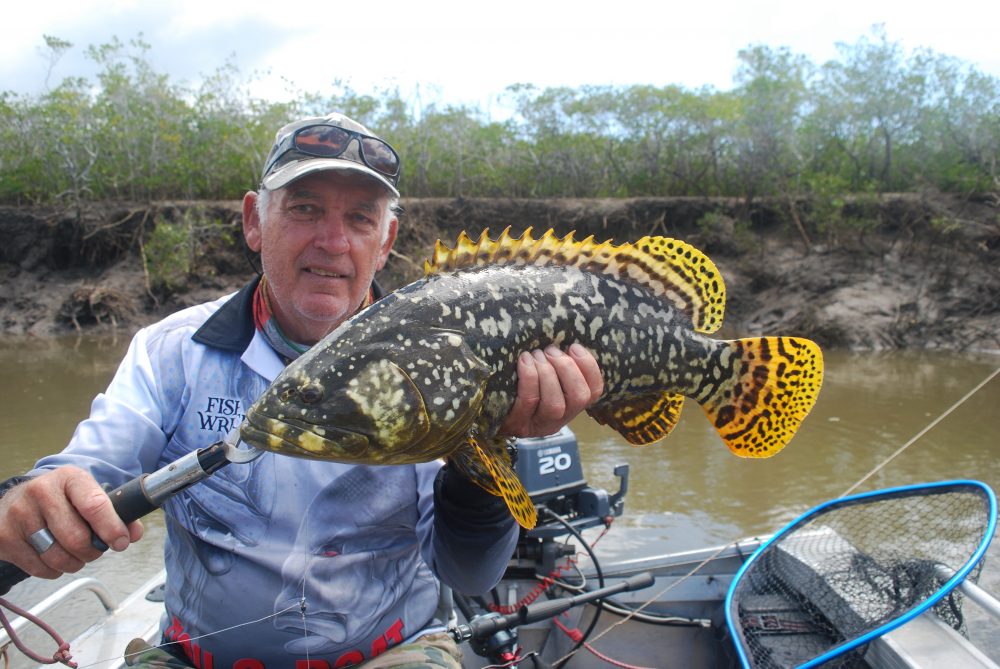
A 63cm grouper from Corio Bay was part of the catch in the quest for the metre barra
The plan was for them to stay three, or four, days with Lorraine and I here at the house. This would give us a base from which to plan our fishing trips and to chill out during the down time. Adrian’s only request was a metre plus barra, caught on live-bait. We discussed in detail, this, what could be considered, unusual request!
Being a very committed and energetic fisher, the arsenal of rods, reels and lures that arrived, along with his 4.65mtr Sea Jay, was quite impressive. And undoubtedly there was more of the same back in Bundaberg. However, even with this gear and apart from the 1000-odd barra that he had caught over the years of fishing the Cape and throughout parts of the lower Gulf of Carpentaria, including the Northern Territory, a metre long fish had eluded him. The bait part was all about, “because he wanted to!” Simple! Now to sort out the Full Moon tides and the options they provided.
When working both the Full Moon, or the New Moon spring tides, it is the tidal differential which is the important factors to consider. The differential range of October’s Full Moon on the Capricorn Coast showed a range variation of 3.61m in the morning and 2.75m, occurring during the afternoon ebb and early evening flood: nearly a metre difference in tidal range. This gentler flow both ways in the movement of the afternoon tide would give a longer “bite time” leading up to the Moon Rise. Under such conditions I had just the spot where big fish might be gathering, and holding.
Even with the major bite time not occurring until just after lunch; Friday, at 5.30am saw us negotiating the track into Corbetts Landing. Situated on the western bank of Waterpark Creek, the main estuary flowing into Corio Bay, it is the preferred access point when fishing the bay. The usual welcoming party of sandflies and mosquitoes were there waiting; just in case we had any doubts as to our location!
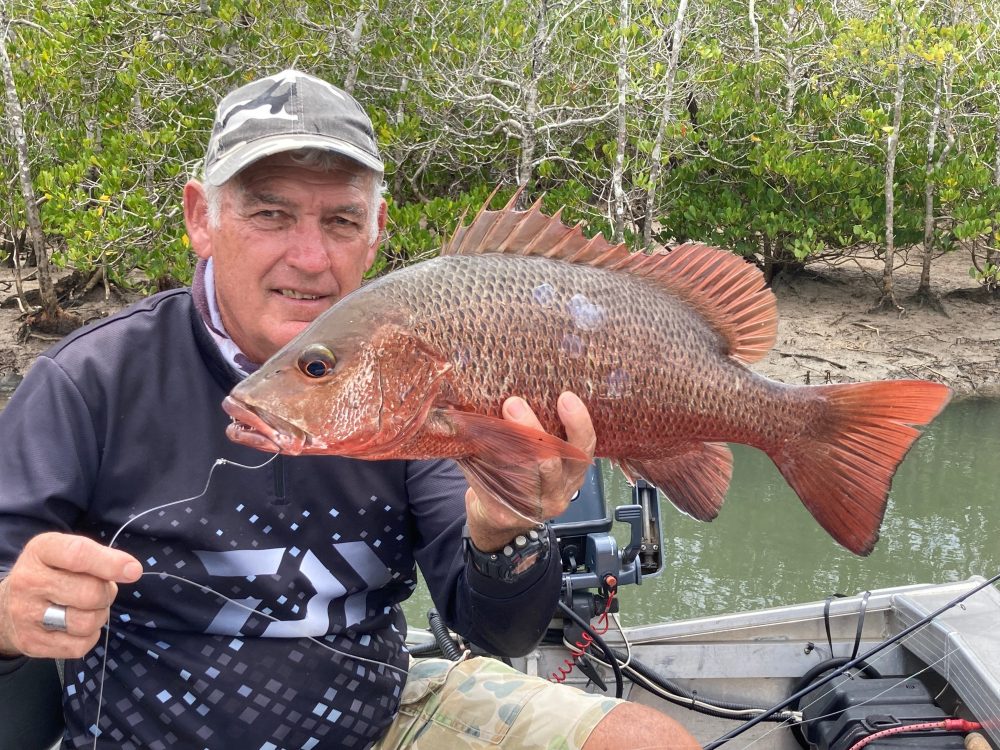
56cms of angry mangrove jack. A PB for Bill after 50 years of targeting them. The hook – a Gamakatsu 5/0 Shiner wide-gap
Corio Bay, is one of those unique places that occur every now and again along our coastline. It is a bay, within a bay (Keppel Bay). And as such, has its own characteristics of creeks, estuaries, channels and most importantly, tidal flows. There are four major creeks which flow into Corio Bay. They are Fishing Creek, Deep Creek, Sandfly Creek and Waterpark Creek. All have their own little complex delta systems where they meet the bay proper. Add to this, rocky headlands, upstream and central bay rock bars, sandbars and mud banks, then like I said, “unique”. We picked our spot and entered the bay beyond the Solero Bank on the southern side of Waterpark Creek.
Although the plan was to fish baits for barra, the clear waters of the bay on a making tide were just too good to pass up without, at least, an exploratory cast with lure. Adrian dropped the Motor Guide electric. We sounded and scanned. My little Sea Jay Nomad, with the Helix Nine, tracked about 15 metres off, and parallel, to the mangrove lined bank. Zerek prawns and various hard bodied lures worked in and out of the little nooks and crannies made by broken timbers of mangroves and collapsed mud banks.
Small gold spot cod offered a bit of excitement, as did small pikey bream and the occasional tarpon. But try as we might the barra were not responsive, nor visible on either side, or down scan. We gave it away and went cast netting for mullet and large greenback herring, to make up the afternoon’s bait supply. The tide had run its course, and was now on the start of the ebb.
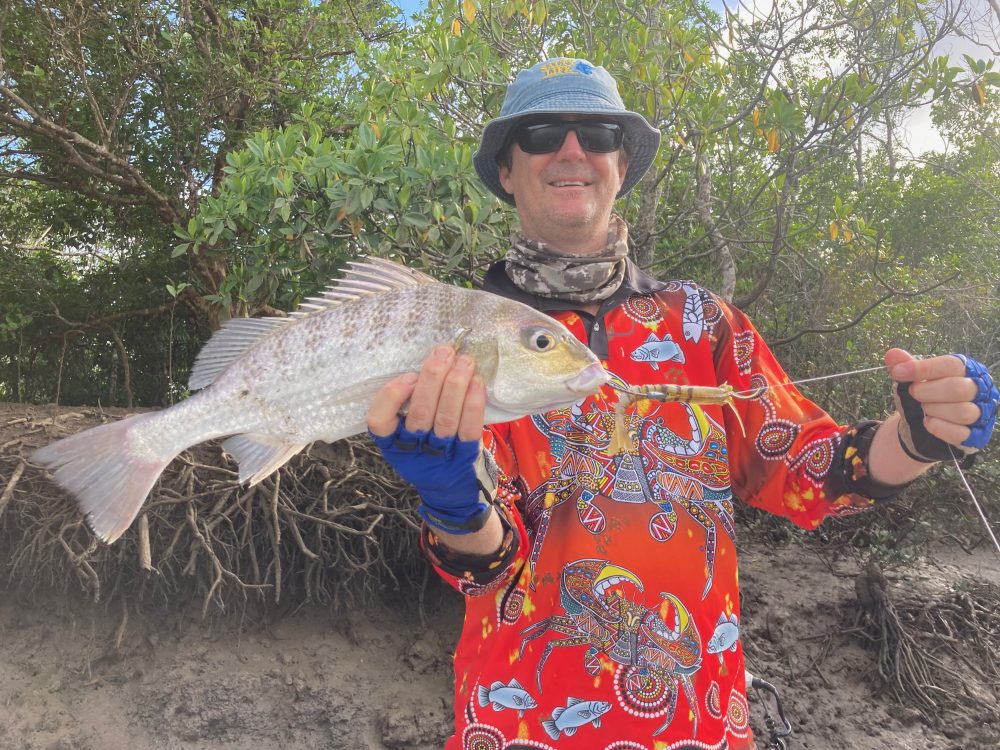
Adrian with a nice, day two, caught grunter of 45 cms. The lure, a Zerek prawn
Out on the rapidly emerging mudbanks, bait was easy to gather. We secured a good supply and moved up just inside a channel of one of the creek mouths where, both a bow anchor, and a “holding” anchor from the stern, were set. The Humminbird showed that the bow was holding over the edge of the channel – an ideal position, where a big live bait could be set. Away to the south-west, storm clouds gathered over the Coastal Ranges and the sounds of thunder could be heard.
“Too far south for us to worry!” I stated. Adrian’s rod took a solid strike. It was a bull shark which cut the bait off in a very short space of time.
Fish number two was another gold spot cod, which was grateful to be returned to the water. Adrian’s third strike was a nice barra. This big fish ran down along the channel and then turned wide, before swirling at the surface, rolling and throwing the hook.
What a disappointment! And although it was not a metre barra, it was still a good-sized fish of around 80cms. Fish number four, a blue threadfin, swirled to the surface and took a long and powerful run towards the open bay. The hook again pulled. Fish were on the move and it would only be a matter of time before the barra would move along the channel. The hook situation needed inspection.
The style of hook Adrian was using was a chemically sharpened circle hook. It was brand new and in perfect condition. It was a style of hook with which he has had a lot of success. However, this primary success has come when deep fishing the reefs wide of Bundaberg, not when live-baiting in creeks and rivers. And herein lies the difference.
Fish hooks come in all shapes and sizes. The reason is simple and singular; they are designed for a specific purpose. Certainly, there are times when one hook serves multiple tasks – single hook vs a treble when live baiting; single vs treble on lures; catching a 93cm barra on a #4 whiting hook – these are real cases. However, the use of a specific hook design for the type of fishing you are doing will increase your chances to successfully hook, and land, a fish.
The design concept of a circle hook is for the hook to roll (inside the mouth of a fish) when pressure is applied. By rolling, the point of the hook will take purchase on a surface (usually the mandible -jaw). Then, as further pressure is applied, either by the angler, or the fish itself, the resultant vector forces on the point of the hook will force it deeper into the jaw of the fish. In extreme cases if the point is forced through the jaw and takes purchase on the OUTSIDE of the mouth, more applied pressure can force the entire hook to also end up outside of the mouth. This action of forces on the point of a circle hook is most effective when fished vertically, or near vertical eg when reef lining, or drop- lining in deep water.
In the case of fishing away from a boat, pier, or bank where the line lies between 25 – 60 from the horizontal the effects of the forces needed to set a circle hook are far less. This is even-more-so when the bait is sitting on the bottom of the creek/estuary, or when the fish has taken the bait and cannot swim down, forcing the hook to roll. A simple test to validate the actions of a circle hook is to work the hook against the corner of the kitchen table, or a workbench. Apply pressure at varying angles and note how the hook takes hold, then move those angles of pressure and again watch how the point of the hook performs. Vertical it will bite ; horizontal it will initially bite then, pull.
When fishing baits, both live and dead, it is very hard to go past either the wide-gap, or the octopus design of hook – both chemically sharpened, of course. My preference has always been for the wide-gap design ever since it was first manufactured by the French company, Kahle. Today I specifically use the Gamakatsu Shiner wide-gap in both the 4/0 and 5/0 size range.
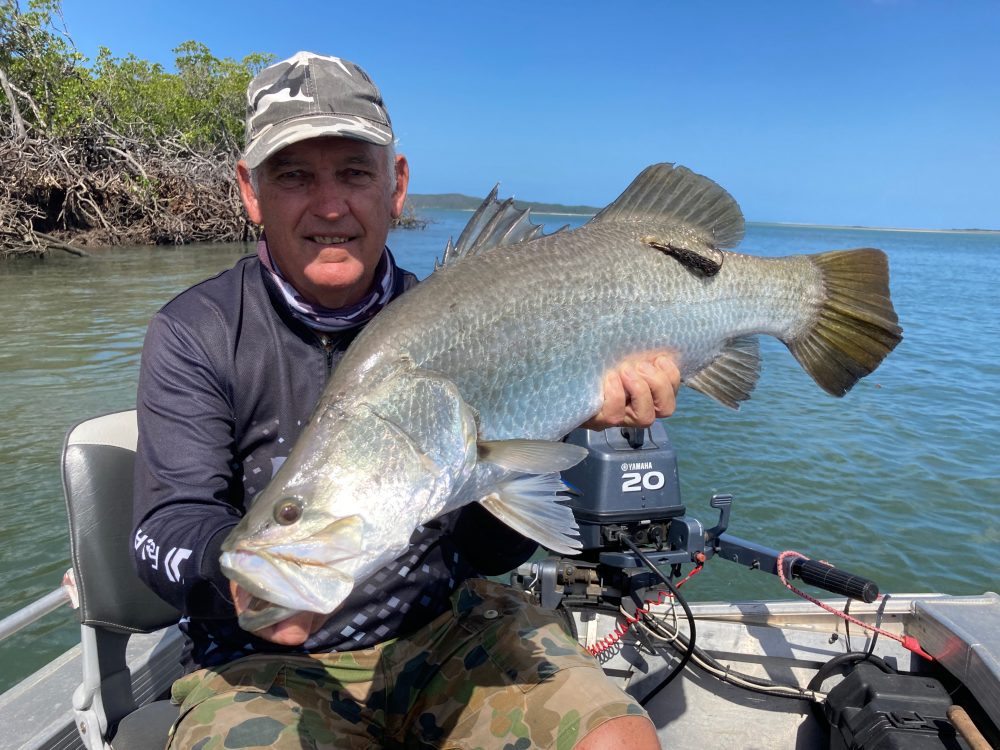
Fishing the afternoon ebb tide at Greenslopes – a live bait; Dobyns rod and an 81cm barra. Note the weed covered tag from a previous capture
The waters were now fast ebbing off of the mudflats and the myriad of channels were becoming clearly defined. The near-shore single snag that we were fishing back to, started to break the surface. We had about an hour’s fishing before we had to move out of the creek mouth. My little Dobyns Sierra Series SA 684 C kicked in the rod holder, then held fast. First call was a cod which had me deep into the snag.
I took the rod and held the pressure. The fish reacted and started “biting” at the invisible force, sending jarring reverberations right back to the rod butt. No cod this one. It was a jack. We played see-saw over, and under, the tree trunk for nearly 15 minutes. I was thankful for the 60lb Shimano Tiagra shock leader that I was using.
In a last-ditch effort to try and escape around the snag, the jack left the cover and made a dart for the broken line of the channel. The Dobyns performed beautifully and stopped the fish in its tracks. In fact, it more than stopped it, but actually slid it towards the surface and arced it towards the side of the boat. It was only then that we got a good look at the size of the brute. A big, broad, coppery-red head, two large-ringed, flashing eyes and two snapping canine teeth capable of inflicting a nasty wound: it was big. A scoop of the net, and it was mine. At 56cms it was my biggest ever. That fish made my day. The dropping tide forced a move. It was nearing 3pm.
Corio Bay has several minor creeks and gutters which flow into the myriad of crisscrossing channels. They all hold bait and as such, all hold fish. Most are too small to hold metre plus fish. But the accompanying, and nearby channels, are the places to search to check out where these bigger fish may be holding. We anchored up. It didn’t take long. The little Dobyns was on fire.
The run in the tide had steadied. The difference of that metre of water between high and low, not only meant that the flow was gentler, but it also meant that the bigger fish would holdout right along the channel before again foraging on the making tide. The barra jumped. It was a good fish at around the 80cm mark. The Dobyns again performed superbly. Adrian was deft with the net. We went home happy fishers. The storm, as expected, stayed to our south. It had a marked influence over the next two days.
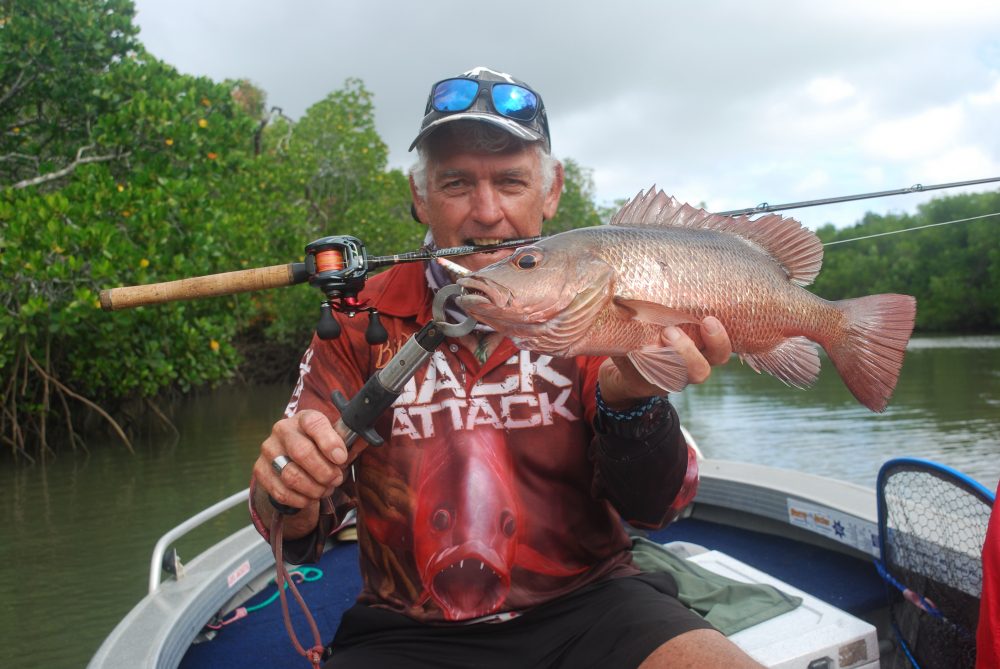
A Diawa Tatulion reel; Dobyns rod; Richo lure and 49cm jack – a lethal combination at the end of season
Day two and we stayed in the Corio Bay system fishing upstream of Corbetts Landing in Waterpark Creek. The preference was to work lures amongst all of the fallen timber and shallow rock bars which at certain times hold good fish, especially barra and king threadfin. Adrian landed a nice grunter taken on a Zerek prawn. It could be seen feeding on jelly prawns in amongst a standing patch of sunken mangrove timber. The strike was vicious. But it was the only one for the day.
Back home we reassessed the situation. There were certainly barra about. The October Full Moon period would have seen many of these fish school up and undergo a spawning cycle down around the mouths of the main estuaries. However, once spawning had taken place, the fish would be heading back upstream to the deeper holes to rest, feed and recuperate. Day three was Sunday, three days after the Full Moon. The morning tidal differential was 2.91m, with high tide at 11:00am.
Coorooman Creek is a big waterway. To me, with its complexity of mangroves, rocks, sand, mud, deep holes, gutters and tributaries, it is the most complete creek system that I have ever fished. We continued our fishing in Coorooman on day three as the big barra moved upstream on the making tide.
From the outset the day was a success. Bait was easy to get along the sandbanks and at the mouths of the mud gutters. The storms that had missed us two days before at Corio Bay, dumped between 40-50mm of rain at the headwaters of Coorooman creek putting a “sweet edge” to the water. Birdlife was everywhere chasing the small baitfish fidgeting along the water’s edge. And my family of Brahminy Kites were there to meet me. Beautiful!
What happened next was storybook stuff. We pulled up at a favourite old spot. A bow anchor and stern line were set adjacent to the steep bank. Adrian laid out a long cast to the junction of two channels. His bait was a 20cm mullet. I laid out a short cast on my Edge MBR 777-1 rod and Diawa Tatulion HD TWS Custom reel. The line was 40lb Sufix 832 braid. A complete outfit. The bait was a 15cm mullet. Out of pure habit, I grabbed my trusty old wooden hand reel, with its equally old 40lb Schnider line (both about 48years old), sliced a slab of mullet from a freshly netted 35cm fish; pinned the bait in the corner with the 5/0 wide-gap hook and laid it out down along the edge of the bank, with the words, “one of the best baits for a big, old barra, looking for an easy feed!’
Adrian’s rod went off. It was a barra. It knew all the tricks and after going upstream, it turned and came back straight towards the boat and the bow anchor rope. Adrian dropped the rod to clear the line. The fish got some slack, turned again, picked up the braid in its gill-rakers (operculum) and cut the braid like cotton. More disappointment!

Bill’s trusty old wooden spool hand line. It has accounted for many metre plus Barra and other fish
The handline then kicked at the back of the boat as the two coils of slack line were taken up. A big fish boiled to the surface. Then dived. It swung wide of the steep bank and mangroves then came to the surface again, rolling and displaying a big, broad, yellow tail – a barra, and a big one! It was definitely a metre plus fish.
On the handline it performed a treat, coming clear of the water on one occasion and then head and shoulders on another. Finally, getting it boat side, it was too big for the net so had to be man-handled over the side. She went 119cms. There was elation and disappointment in one. We were both happy to finally get a metre fish into the boat. I looked at my old handline, then at the array of expensive rods and reels, and laughed. Adrian looked at the big fish and thought of what might have been. He’ll be back. That has already been arranged for next year.
And the big girl? Well, she will be back also. After 20minutes of swimming her, tickling her belly and stroking her sides, she rolled, turned both eyes towards me bit down three times onto my thumb, and held the last bite. I gently released her into the current, rubbing her sides as she went. She swam, turning away into the channel. A lost love!


